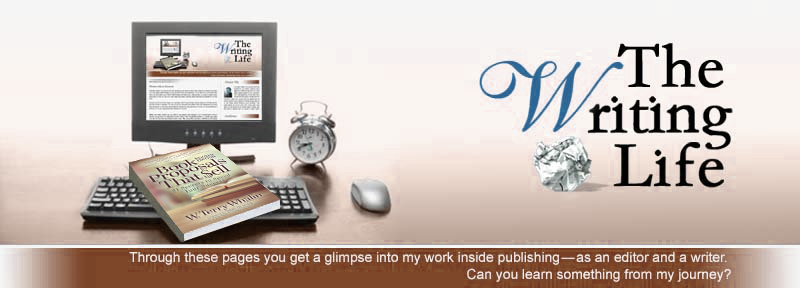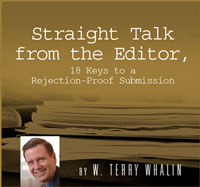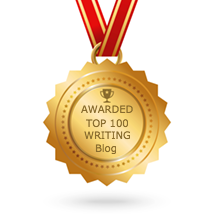As I read the queries and pitches that come to me as a literary agent, I'm continually amazed at the incomplete submissions--whether it is a one page query letter or a book proposal and sample chapters or a fiction submission.

Why is it a problem for these writers? They want to get their book idea published yet because they don't present a thorough, professional and complete submission (query or proposal), then it is like they stand there and beg for rejection. Because of the volume of these submissions, I can almost guarantee they will receive a form rejection letter and nothing that explains their idea was never fully considered because they were missing a piece of the puzzle.
For example, let's look at a query which I received from a writer. After I read the pitch, I could not tell if it was fiction or nonfiction. So I asked--effort on my part to send a message. I learned it was fiction.I asked again--what type of fiction, young adult or adult? What was the length (the word count--because if I'm not specific it is almost inevitable they will respond with the number of pages and cause more correspondence)? Through a series of emails (which almost no acquisitions editor or literary agent will do), I learned this writer was pitching a 31,000 word novel.
Do you see the problem? It's not a full-length novel and this writer needs to return to her manuscript and add at least 20,000 additional words. Ironically she first pitched a bunch of publishers who told her they only took work from literary agents. Now she's pitching a bunch of literary agents--and in reality, doesn't have anything to pitch because it is too short.
And you may be one of those writers who has sent a submission and haven't received an answer or you wonder why it takes so long to receive a response. It's because of this problematic incomplete packages which are jammed right next to your submission.
Here's one of the keys: Are you pitching a nonfiction book or a fiction book? If nonfiction, then you need a book proposal and several sample chapters before anyone will seriously consider your pitch. If you are pitching a novel, then you need to have written the complete novel before you approach anyone about it. And you need to be enough of a student of the craft to understand the typical word count for your type of novel--and have written your novel within this word count.
If you don't have any idea of the typical word count, then follow this link--and in particular look at the material that I reference in this entry of The Writing Life. Keep that word count front and center because it is one of the easiest way to get a three-second rejection. You want to rejection-proof your submissions.
For your fiction to stand out from the other submissions (always a good thing if you stand out from a positive perspective), you will need to send a page-turning story (always key), a well-crafted synopsis, a short biography of the author and if you really want to show you understand the business of publishing--then I recommend you also include a realistic marketing plan which shows how you plan to sell books. Selling books means doing newspaper, magazine and other media like radio interviews and understanding the journalists will need a nonfiction angle from your novel to talk with you. Otherwise they are stuck and don't know what to ask you about your story. You want to show you understand their dilemma and are prepared for it.
I've rejected a great deal of fiction in recent months--poorly crafted, poorly pitched and the reality is there are less places to sell that fiction than a nonfiction book. While we're talking about sales, the Author's Guild says a typical nonfiction book will sell 5,000 copies in the first year and a fiction book will sell 7,500 copies. These modest numbers may surprise you--especially when you realize you can write a much shorter magazine article of about 1,500 words and easily reach 150,000 readers with many different print magazines.
Now let's turn to a nonfiction package. The key element with nonfiction is the visibility of the author to sell books, which is also called "the author's platform." Do you have this visibility and also is this visibility in the area that you are pitching with this new project? For example, I recently read a women's leadership book where as I looked at the proposal and sample, the author had almost no visibility in the marketplace. She was trying to use her husband's platform as her platform yet her husband was not a co-author in the book and his voice didn't appear in any of the chapters. In other words it was a stretch and took seconds for me to spot. To me that means that it would take seconds for any other editor or literary agent to spot and this person needs to build their platform before they pitch the book idea. Publishers use author's platforms but do not build platforms for authors.
What is in a nonfiction book proposal? Most book proposals range from 15 to 30 pages. These proposals are always 100% typo-free with generous margins. Most frequently a book proposal is double-spaced. The proposal takes many forms and the writer inevitably dictates the shape of the proposal. The common elements include:
Overview. This area could be the most important part of your proposal and should be 1 to 3 pages long. In clear and succinct style it covers: What is the book about? Why the book is important, useful and necessary? Who is the audience? Who will buy this book? What makes the book different or better than any other book in on this subject? What is the book’s marketing handle? This is a twenty word or less description. What can you do to help the book in terms of promotion?
About the Author. Don’t be shy. Why should the editor give you this project? Of everyone in the world why you? Specifically show how you are the most qualified individual for this project.
The Competition. Everyone believes their book is unique. It’s not unique so please detail what other titles would be in direct competition. In fact, if you say there is no competition, you are practically begging for instant rejection.
Manuscript Delivery and Length. In the majority of cases, nonfiction books are not completed so when can you deliver your manuscript and what will be the length (word count) of your manuscript?
Promotion/ Special Markets/ Volume Buy Backs (anything over 5,000 copies). This portion of the proposal may be one of the most important because you will emphasize your ability to sell books.
Chapter Summaries. These summaries are an outline of the book. They can be as long as you desire but no less than 150 words for each chapter. Select the format, which works best for you such as outline, narrative or a bulleted list of key points.
Sample Chapters. You will need at least one sample chapter and probably two or three chapters (if a chapter is less than ten pages). These chapters should give the reader a strong sense of the book’s tone and style. Many editors read the sample first so make sure you show your best work.
I've gone into much greater detail about these elements in Book Proposals That Sell.
Make sure you have thought through the various key elements in your query and your longer submission--whether it is fiction or nonfiction. If you submit a complete package, then your project will receive the deserved consideration rather than instant rejection. It is only through the consideration process that you have any possibility of receiving the joyous email or phone call that says you have a book offer from a publisher.

Labels: book proposal, fiction, nonfiction, rejection, submission




































